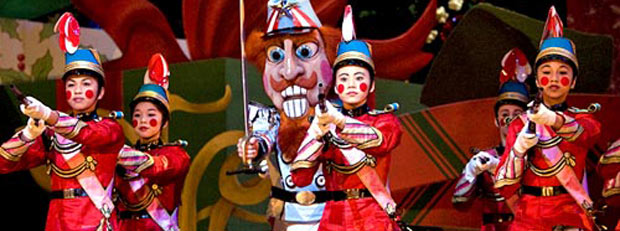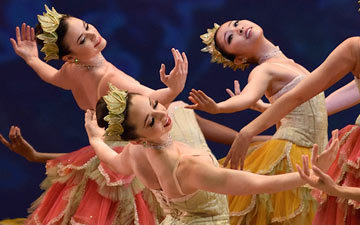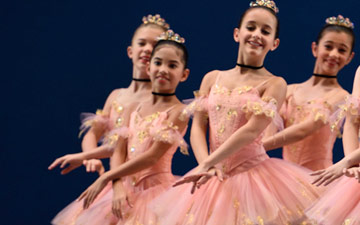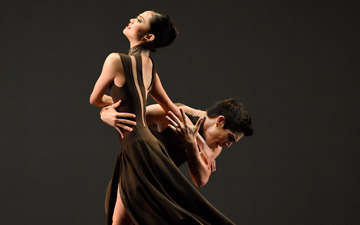
© Erik Tomasson. (Click image for full version)
San Francisco Ballet
Nutcracker
San Francisco, War Memorial Opera House,
December 7, 2012
www.sfballet.org
In 1944 the San Francisco Ballet presented America’s first full-length version of The Nutcracker. With choreography by Willam Christensen, this production, though often viewed as the birth of the now-national tradition of high-class holiday entertainment, wasn’t repeated. Willam’s brother, Lew Christensen, who succeeded him as artistic director in 1952, choreographed his own version for the 1954 season. That incarnation also did not take root. It wasn’t until 1967 when Lew re-choreographed Nutcracker that the company began its run of annual performances. Helgi Tomasson, with the artistic reins in hand since 1985, introduced his own creation of the ballet in 1986 and then concocted the currently-performed 2004 edition of the seasonal cash cow. I have seen the last three of these five versions more than once and must admit that I still prefer Christensen’s.
Not to be a scrooge-ish Grinch (or is it a grinchy Scrooge?), but I don’t really like all the sentimental and consumeristic trimmings and trappings that surround the holidays. For that reason, this opening night is particularly grating – the lobby filled with glittery decorations and children dressed to the teeth in velvet, sequins, bows and brocade – just give me the dancing, please.

© Erik Tomasson. (Click image for larger version)
And some very good dancing I do see after all. In the party scene, thankfully, there are not hordes of children, only a dozen who can be seen clearly as individuals and one can appreciate how well they execute the simple steps they are given. All three dolls are splendid. Lonnie Weeks as the Jack-in-the-Box surely has pogo-stick feet that propel him into light, lofty jumps and rubber limbs that make his artistic contortions effortless. Clara Blanco’s Ballerina is beyond perfection, impeccably crisp technique coupled with the requisite robotic quality, yet with a faint soupçon that she’s just putting one over on us, or is she? Despite the handicap of the gigantic Nutcracker head, Hansuke Yamamoto delivers the turns and jumps with jaunty military flair as if he were unencumbered. Warmly engaging portrayals of the Stahlbaum parents by Pascale Leroy and Ricardo Bustamante, and Anita Paciotti and Jim Sohm as the Grandparents only prove how important the small details are in defining this scene.
The moment the Nutcracker Prince is transformed from an inanimate wooden figure into a live person, Davit Karapetyan is free to claim the entire stage with his magnificent presence. His admirably concise technique and insightful interpretations always lure us in and then we can relax and be simply awash in the mutual confidence that he inspires. He will dance gorgeously and we will joyfully watch.
Once through the Land of Snow we warm up in the garden of the Crystal Palace where the ever-regal Sofiane Sylve as the Sugar Plum Fairy is our gracious hostess. The best of the second act variations includes the versatile Lonnie Weeks in the Chinese, French Mirlitons Marie-Claire D’Lyse, Kristina Lund and Jennifer Stahl who keep those red ribbons swirling out circles or whipping up undulating waves all while strutting out can-can infused pointe work, and Daniel Deivison in Russian with his non-stop split jumps.

© Erik Tomasson. (Click image for larger version)
For the Grand Pas de Deux, first the young Clara (Natasha Sheehan) steps into a magic cabinet where she is metamorphosed into a grown-up version of herself (Frances Chung) so she can dance with the Prince. Karapetyan is a dream of a partner, showing off Chung in the best possible light while seeming to be doing almost nothing at all. Chung herself is so technically assured that the technique disappears and all that remains is her smiling happiness.
—oOo—
San Francisco Ballet’s Nutcracker continues through December 28th. See www.sfballet.org/tickets/casting for casting.
For a more detailed description of this production please read my review of the premiere in 2004…
DanceInsider Flash Review, 12-23: Land of the Cotton Candy
Stylish New SF Ballet “Nutcracker” Lacks Substantive Choreography
By Aimée Tsao
Copyright 2004 Aimée Ts’ao
SAN FRANCISCO — I suspect that for most ballet critics the pre-Christmas diet of endless “Nutcracker” performances leaves many jaded and longing for January to arrive. I usually take a break, but this holiday season in the Bay Area looked like it might actually offer a respite with two new Nutcrackers. Right after Thanksgiving, Matthew Bourne’s British-based New Adventures company brought his original perspective on that old Tchaikovsky chestnut to Zellerbach Hall in Berkeley. Of course, having been created in 1992 and revised two years ago, this isn’t a new production. We just hadn’t seen it here in this country. After seeing Bourne’s “The Car Man” I wasn’t surprised when his “Nutcracker!” didn’t really grab me. Though the concept, sets and costumes were quite good, there just wasn’t enough choreography to fill an entire evening. So I put my hopes on San Francisco Ballet’s premiere of artistic director Helgi Tomasson’s latest reworking, the first major one of the company’s production in 18 years.
A brief pause while I slap myself for once again ignoring my own rule about not having expectations. It’s not that I had great expectations, but what in the dickens was I thinking when I kept hearing inside reports on some of the difficulties SF Ballet’s new Nutcracker was experiencing? To balance those rumors, I had also heard that the costumes and sets were absolutely gorgeous. I suppose I was giving everyone the benefit of the doubt.
Opening night, Friday, December 17 at the War Memorial Opera House has all the trappings of a grand premiere. Characters from the ballet wander through the lobby while many members of the audience, dressed to the nines, nibble on snacks provided by various sponsors. The atmosphere is truly festive, as befitting the holiday tradition of seeing “The Nutcracker.” It is also appropriate as it is the 60th anniversary of San Francisco Ballet’s first performance of it; in fact, on December 24, 1944, SFB was the first professional company to dance the entire Tchaikovsky ballet in the United States.
Even before the show begins I am treated to a glimpse of what is to come. The painted stage curtain, in the style of a Victorian greeting card, welcomes me as I take my seat. As the overture begins there is a brief slide show of scenes of early San Francisco, then a zooming in on a storefront that advertises “Drosselmeyer Fine Clocks,” while the curtain rises to reveal the interior of the shop with Drosselmeyer himself putting the finishing touches on the Nutcracker he will give to Clara. The rumors prove to be true — the sets and costumes are exquisite.
The street in front of the Stahlbaums’ house is a row of San Franciscan Victorians and the people are dressed in gowns and suits of the early 1900s. It is quite gratifying to feel the action is taking place here in our own city. One of the best touches is the grand staircase in the living room, which allows for some sweeping entrances and exits, and literally lifts the action so it can be clearly seen. The story line in the First Act is pretty much the usual one, though as Clara falls asleep and begins to dream, the mechanical dolls that performed earlier make brief appearances as does brother Fritz with his drum, before Drosselmeyer emerges through the floor in a swirling cloud to take control of transforming the living room for the battle scene with the mice. Here I begin to sense something is amiss. This battle scene is the most sedate one I’ve ever seen. Yes, it has several humorous touches: the Mouse King emerging from a hole where the prompter’s box would be, then being caught in a giant mousetrap carried on by soldiers and finally crawling and disappearing head first into his hole, with twitching legs lingering before vanishing. But it definitely needs more action, chaos and energy to be rightfully called a battle.

© Erik Tomasson.
For the Land of Snow, the glittering tree branches framing the stage even suggest the shape of snowflakes. Again, the costumes are sumptuous but the look of snow never gets to feel like a real snowstorm. The choreography is rather staid instead of whirling madly and flying across the stage driven by an icy wind. Even the variety of steps is severely limited, unlike snowflakes, of which no two are alike.
Press packets being an interesting source of information, at intermission I consult mine to see what everyone (Tomasson for choreography, Michael Yeargan for scenic design, Martin Pakledinaz for costume design and James F. Ingalls for lighting design) claims as their inspiration for their individual contributions to the production. The intentions for the second act are honorable, but some of them just aren’t quite realized. Instead of the usual Kingdom of Sweets we have a Pavilion of Dreams, a good concept illustrated by gracefully curving white ironwork arches floating above the ground, echoing the architecture of the Pan Pacific Exposition held in 1915 in San Francisco.
Colorful butterflies, ladybugs and dragonflies flit across the stage. So why is the Sugar Plum Fairy intruding in this idyllic garden? Only by using my opera glasses from the 14th row can I see that her costume does have tiny pink roses on the bodice. And even more puzzling, why is she dancing the lead in the Waltz of the Flowers? Maybe she could be called the Queen of Roses instead. The music for her variation is later appropriated for the grand pas de deux between Clara (though danced by a principal dancer) and the Nutcracker Prince. Musically, this is total heresy as the culminating duet has its own internal structure, which is broken by this interpolation.
The usual variations have nice touches. The airiness of the set allows for additional scenery or props to be brought in to give a taste of the different countries. Spanish has a giant fan, Arabian uses a giant lamp to conceal a seductive genie, a New Year’s Lion follows the Chinese dancer, the French Mirlitons twirl long ribbons, and the Russians burst out of three enormous Faberge eggs. The steps themselves need to be even more distinguishing. Variations in a ballet are like arias in an opera: they should have movement motifs or phrases that are readily identifiable or unique characterizations created by gestures overlaying a solid structure.
It is rather distracting to have the throne that Clara and Drosselmeyer sit on moved to a new position on the stage before each variation, and particularly so for the Waltz of the Flowers when it is upstage center. That is not the only problem with this dance. The costumes are a bit too pale and are all identical. A corps de ballet of only 16 dancers barely makes a bouquet, and at least half of what they do is literally walk and pose. With such lilting music, if I were on stage I would take off and improvise; choreography, or lack thereof, be damned.
After placing a crown on her head, the Sugar Plum Fairy grants Clara her wish to dance with the Prince. She enters a large cupboard with mirrors inside and emerges moments later, as another dancer in a classical tutu for the aforementioned grand pas de deux. How confusing. A better solution would be to have one dancer be Clara for the entire ballet. After seeing this production a second time with Clara played by Andrea McGinnis, I am even more convinced that this is the best approach. On opening night I saw Caroline Hearst, a student from the school in this role. She did a fine job for a student, but McGinnis, an apprentice with the company, is a much stronger performer, both technically and expressively, which gave more focus to the story. The ballet concludes with Clara waking from her dream still curled up on the sofa cuddling her Nutcracker.
Except for the sublime Tina LeBlanc and gallant Gonzalo Garcia in the grand pas de deux, Pascal Molat in Chinese, Guennadi Nedviguine in Russian and Jaime Garcia Castilla as the Jack-in-the-Box, all in excellent form, the opening night cast in general hadn’t really gotten into their roles. When I came back for a second look last night, the whole cast seemed so much more relaxed and animated on stage.
Once again spectacle takes precedence over substance in our market- and marketing-driven culture. Recalling that some of Balanchine’s early masterpieces were first performed in practice clothes (because there was no money for costumes) is testimony to the idea that choreography should be able to stand on its own. For all the brilliant costuming and scenic and lighting design, underneath there also should be some substance, some solid choreographic ideas.

















Hi Aimee,
Enjoyed your reviews of SFB’s “Nutcracker” a lot. But, as for Matthew Bourne’s version, I know I saw it in LA some years ago. If it’s the same one, set in an orphanage, it was presented at UCLA.
Thank you for writing this. Well done… And I absolutely agree — I much prefer Christensen’s Nutcracker to Tomasson’s.